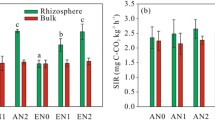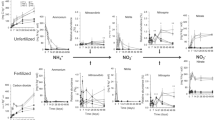Abstract
We have evaluated the effects of oxygen partial pressure (pO2), combined nitrogen, and the availability of organic substrates on nitrogen fixation (acetylene reduction) by bacteria associated with the roots of intact maize and sorghum plants. We also investigated the possibility of enhancing associative nitrogen-fixation by inoculating the soil in which the plants were grown withAzospirillum. Acetylene reduction (AR) activity was greatest when roots of intact plants were exposed to pO2 between 1.3 and 2.1 kPa. Field-grown and greenhouse-grown plants supported similar levels of activity. Respiration inhibitors (2,4-dinitrophenol and sodium azide) eliminated AR activity at 2 kPa O2, whereas a fermentation inhibitor (sodium fluoride) only partially reduced the activity. Acetylene reduction activity was rapidly (1–3 h) inhibited by NH +4 , NO −3 , and NO −2 at concentrations of 4–20 mg Nl−1. Rates of AR varied substantially among individual plants in each experiment and between experiments. Amendment with any of several organic substrates greatly increased AR activity when rates were low, suggesting that the lack of activity was caused by a shortage of available carbon in the rhizosphere. Inoculation withAzospirillum failed to increase rates of AR associated with maize plants. In several experiments the indigenous bacteria associated with uninoculated plants exhibited greater activity than the bacteria associated with inoculated plants.
Similar content being viewed by others
Abbreviations
- AR:
-
acetylene reduction
- ADS:
-
anthrone-detectable sugars
- DNP:
-
dinitrophenol
- DOC:
-
dichromate-oxidizable carbon
References
Albrecht S L, Okon Y, Lonnquist J and Burris R H 1981 Nitrogen fixation by corn-Azospirillum associations in a temperate climate. Crop Sci. 21, 301–306.
Alexander D B, Zuberer D A and Vietor D M 1987 Nitrogen fixation (acetylene reduction) associated with roots of intactZea mays in fritted clay at reduced oxygen tensions. Soil Biol. Biochem. 19, 1–6.
Avivi Y and Feldman M 1982 The response of wheat to bacteria of the genusAzospirillum. Israel J. Bot. 31, 237–245.
Balandreau J, Ducerf P, Hamad-Fares I, Weinhard P, Rinaudo G, Millier C and Dommergues Y 1978 Limiting factors in grass nitrogen fixation.In Limitations and Potentials for Biological Nitrogen Fixation in the Tropics. Eds. J. Döbereiner, R H Burris and A Hollaender. pp. 275–302. Plenum Press, New York.
Baldani J I, Baldani V L D, Seldin L and Döbereiner J 1986 Characterization ofHerbaspirillum seropedicae, gen. nov., sp. nov., a root-associated nitrogen-fixing bacterium. Int. J. Syst. Bacteriol. 36, 86–93.
Barber L E, Russell S A and Evans H J 1979 Inoculation of millet withAzospirillum. Plant and Soil 52, 49–57.
Brink R H, Dubach P and Lynch D L 1960 Measurement of carbohydrates in soil hydrolysates with anthrone. Soil Sci. 89, 157–166.
Burris R H 1977 A synthesis paper on nonleguminous N2-fixing systems.In Recent Developments in Nitrogen Fixation. Eds. W Newton, J R Postgate and C Rodriguez-Barrueco. pp. 487–511. Academic Press, London.
Cejudo F J and Paneque A 1986 Short-term nitrate (nitrite) inhibition of nitrogen fixation inAzotobacter chroococcum. J. Bacteriol. 165, 240–243.
Chaney A L and Marbach E P 1962 Modified reagents for determination of urea and ammonia. Clin. Chem. 8, 130–132.
Cohen E, Okon Y, Kigel J, Nur I and Henis Y 1980 Increase in dry weight and total nitrogen content inZea mays andSetaria italica associated with nitrogen-fixingAzospirillum spp. Plant Physiol. 66, 746–749.
Dawes E A and Large P J 1982 Class I reactions: Supply of carbon skeletons.In Biochemistry of Bacterial Growth. Eds. J Mandelstam, K McQuillen and I Dawes. pp. 125–158. Blackwell Scientific Publications, Oxford.
Day J M, Neves C P and Döbereiner J 1975 Nitrogenase activity on the roots of tropical forage grasses. Soil Biol. Biochem. 7, 107–112.
Döbereiner J, Day J M and Dart P J 1973 Rhizosphere associations between grasses and nitrogen-fixing bacteria: Effect of O2 on nitrogenase activity in the rhizosphere ofPaspalum notatum. Soil Biol Biochem. 5, 157–159.
Drew M C and Sisworo E J 1979 The development of waterlogging damage in young barley plants in relation to plant nutrient status and changes in soil properties. New Phytol. 82, 301–314.
Drozd J W, Tubb R S and Postgate J R 1972 A chemostat study of the effect of fixed nitrogen sources on nitrogen fixation, membranes and free amino acids inAzotobacter chroococcum. J. Gen. Microbiol. 73, 221–232.
Grineva G M 1961 Excretion by plant roots during brief periods of anaerobiosis. Soviet Plant Physiol. 8, 549–552 (English translation).
Haahtela K, Kari K and Sundman V 1983 Nitrogenase activity (acetylene reduction) of root-associated, cold-climateAzospirillum, Enterobacter, Klebsiella, andPseudomonas species during growth on various carbon sources and at various partial pressures of oxygen. Appl. Environ. Microbiol. 45, 563–570.
Hiatt A J and Lowe R H 1967 Loss of organic acids, amino acids, K and Cl from barley roots treated anaerobically and with metabolic inhibitors. Plant Physiol. 42, 1731–1736.
Hoagland D R and Arnon D I 1950 The water-culture method for growing plants without soil. Calif. Agric. Exp. Sta. Circ. No. 347.
Hom S S M, Hennecke H and Shanmugam K T 1980 Regulation of nitrogenase biosynthesis inKlebsiella pneumoniae: Effect of nitrate. J. Gen. Microbiol. 177, 169–179.
Johnson M J 1949 A rapid micromethod for estimation of non-volatile organic matter. J. Biol. Chem. 181, 707–711.
Kapulnik Y, Kigel J, Okon Y, Nur I and Henis Y 1981 Effect ofAzospirillum inoculation on some growth parameters and N-content of wheat, sorghum and panicum. Plant and Soil 61, 65–70.
Klugkist J and Haaker H 1984 Inhibition of nitrogenase activity by ammonium chloride inAzotobacter vinelandii. J. Bacteriol. 157, 148–151.
Laane C, Krone W, Konings W N, Haaker H and Veeger C 1980 Short-term effect of ammonium chloride on nitrogen fixation byAzotobacter vinelandii and by bacteroids ofRhizobium leguminosarum. Eur. J. Biochem. 103, 39–46.
Magalhães F M, Baldani J I, Souto S M, Kuykendall J R and Döbereiner J 1983 A new acid-tolerantAzospirillum species. Anais Academic Brasiliera Ciência 55, 417–430.
Nelson L M and Knowles R 1978 Effect of oxygen and nitrate on nitrogen fixation and denitrification byAzospirillum brasilense grown in continuous culture. Can. J. Microbiol. 24, 1395–1403.
Neyra C A and Döbereiner J 1977 Nitrogen fixation in grasses.In Advances in Agronomy vol. 29. Ed. N C Brady. pp. 1–38. Academic Press, New York.
Neyra C A, Pereira P A, von Bülow J F W and Döbereiner J 1976 11th Reunião Brasileira Milho Sorgo, Piracicaba, São Paulo, Brazil. Cited by Neyra C A and Döbereiner J (1977) Nitrogen fixation in grasses. Advances in Agronomy vol. 29. Ed. N C Brady. pp. 1–38. Academic Press, New York.
Neyra C A and van Berkum P 1976 11th Reunião Brasileira Milho Sorgo, Piracicaba, São Paulo, Brazil. Cited by Döbereiner J (1977) Physiological aspects of N2 fixation in grassbacteria associations.In Recent Developments in Nitrogen Fixation. Eds. W Newton, J R Postgate and C Rodriguez-Barrueco. pp. 513–529. Academic Press, London.
O'Hara G W, Davey M R and Lucas J A 1981 Effect of inoculation ofZea mays withAzospirillum brasilense strains under temperate conditions. Can. J. Microbiol. 27, 871–877.
Ogan M T 1983 Factors affecting nitrogenase activity associated with marsh grasses and their soils from eutrophic lakes. Aquatic Bot. 17, 215–230.
Okon Y 1982Azospirillum physiological properties, mode of association with roots and its application for the benefit of cereal and forage grass crops. Israel J. Bol. 31, 214–220.
Okon Y 1985Azospirillum as a potential inoculant for agriculture. Trends Biotechnol. 3, 223–228.
Okon Y, Heytler P G and Hardy R W F 1983 N2 fixation byAzospirillum brasilense and its incorporation into hostSetaria italica. Appl. Environ. Microbiol. 46, 694–697.
Okon Y, Houchins J P, Albrecht S L and Burris R H 1977 Growth ofSpirillum lipoferum at constant partial pressures of oxygen, and the properties of its nitrogenase in cell-free extracts. J. Gen. Microbiol. 98, 87–93.
Saglio P H, Raymond P and Pradet A 1983 Oxygen transport and root respiration of maize seedlings. A quantitative approach using the correlation between ATP/ADP and the respiration rate controlled by oxygen tension. Plant Physiol. 72, 1035–1039.
Schank S C, Weier K L and MacRae I C 1981 Plant yield and nitrogen content of a digitgrass in response toAzospirillum inoculation. Appl. Environ. Microbiol. 41, 342–345.
Smith R L, Schank S C, Milam J R and Baltensperger A A 1984 Responses ofSorghum andPennisetum species to the N2-fixing bacteriumAzospirillum brasilense. Appl. Environ. Microbiol. 47, 1331–1336.
Tarrand J J, Krieg N R and Döbereiner J 1978 A taxonomic study of theSpirillum lipoferum group, with descriptions of a new genus,Azospirillum gen. nov., and two species,Azospirillum lipoferum (Beijerinck) comb. nov. andAzospirillum brasilense sp. nov. Can. J. Microbiol. 24, 967–980.
van Berkum P and Bohlool B B 1980 Evaluation of nitrogen fixation by bacteria in association with roots of tropical grasses. Microbiol. Rev. 44, 491–517.
van Berkum P, Neyra C A and von Bülow J F W 1976 11th Reunião Brasileira Milho Sorgo, Piracicaba, São Paulo, Brazil. Cited by Döbereiner J (1977) Physiological aspects of N2 fixation in grass-bacteria associationsIn Recent developments in Nitrogen Fixation. Eds. W Newton, J R Postgate and C Rodriguez-Barrueco. pp. 513–529. Academic Press, London.
van Berkum P and Sloger C 1983 Interaction of combined nitrogen with the expression of root-associated nitrogenase activity in grasses and with the development of N2 fixation in soybean (Glycine max L. Merr.). Plant Physiol. 72, 741–745.
Yoch D C and Whiting G J 1986 Evidence for NH +4 switch-off regulation of nitrogenase activity by bacteria in salt marsh sediments and roots of the grassSpartina alterniflora. Appl. Environ. Microbiol. 51, 143–149.
Zuberer D A and Alexander D B 1986 Effects of oxygen partial pressure and combined nitrogen on N2-fixation (C2H2) associated withZea mays and other gramineous species. Plant and Soil 90, 47–58.
Author information
Authors and Affiliations
Rights and permissions
About this article
Cite this article
Alexander, D.B., Zuberer, D.A. Impact of soil environmental factors on rates of N2-fixation associated with roots of intact maize and sorghum plants. Plant Soil 110, 303–315 (1988). https://doi.org/10.1007/BF02226811
Issue Date:
DOI: https://doi.org/10.1007/BF02226811




